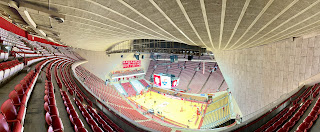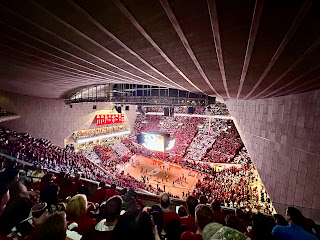I'm finishing up some work on explicit tornado pathlength forecasts,
and plan on reviewing notable cases during the coming months to
compliment my pathlength research. The 9 December 2023 TN/KY event is a
good case to start off my review endeavor, and particularly the
moderately long-track tornado that initiated in Montgomery County
Tennessee at around 1941 UTC and then moved northeast into adjacent
Kentucky. Total pathlength spanning three different National Weather
Service county warning areas was around 43 miles//69 km, and was given
an EF3 damaging rating and also killed several people. The long-track
tornadic supercell developed along/ahead of a surface cold front that
was associated with a fairly sharp mid/upper-level trough. The trough
was also associated with a 125+ kt 250 mb southwesterly jet that spread
downstream at an angle that was somewhat parallel to the surface front. A
40+ kt south-southwesterly 850 mb jet was also present along/ahead of
the cold front. Surface observations at 22-23 UTC showed temperatures in
the mid to upper 60s with dewpoints in the mid 50s to near 60F. This is
fairly typical for early December Mid-South tornado events.
The
RAP KBNA 23UTC analysis sounding showed that lapse rates were not
particularly steep, and MLCAPE values were generally on the low side
(near 500 J/kg). However, wind profiles became increasingly favorable
for longer tornado pathlengths going into the mid to late afternoon
hours across WRN/Middle TN and WRN/SCNTRL KY, though model guidance may
have been several hours late in the generation of those wind profiles.
Nevertheless, using the 23UTC KBNA RAP analysis sounding, the algorithm
I'm testing yielded a predicted tornado pathlength of 54.6 km (or 34
miles), which was around 14 km less than the observed pathlength. It
should be noted that this pathlength forecast was valid for Nashville,
which was several tens of miles south-southeast of where the long-track
event occurred, thus the pathlength prediction might be different if a
closer analysis sounding was available.
A few factors that
favored longer-track tornadoes this day included the shape of the
hodograph, which featured a classically strong veering wind shear
profile from the surface through 10 km AGL. That profile likely aided in
strong storm-scale lifting via cold-pool shear interactions as well as
updraft-shear interactions. In addition, storms moved fairly quickly
downstream, which increased storm-relative inflow as well as downstream
translation. Furthermore, the thermodynamic profile, though not
particularly unstable, was sufficiently unstable to maintain renewed
storm-scale updraft development, and the thermodynamic profile was cool
and humid, which likely precluded excessively dense/stable surface cold
pool development and perhaps excessive updraft dilution via mixing with
the environment. Finally, a quasi-discrete mode of convection was
observed. Factors that inhibited longer pathlengths included only
moderate 0-1 km AGL mean streamwise vorticity (around 0.0155 s-1 from
the 23UTC KBNA RAP sounding).
One final note, I am testing a new
method for predicting supercell motion, and this new method solidly
outperformed the ID Method. The velocity error for the u-component of
motion was -0.5 m/s for the new technique versus 2.9 m/s for the ID
Method. And the error for the v-component of motion was 1.6 m/s for the
new technique versus 9.7 m/s for the ID Method. A robust test dataset
will be presented in a future paper.
 |
250 mb valid 00 UTC 12/10/2023.
|
 |
500 mb valid 00 UTC 12/10/2023.
|
 |
700 mb valid 00 UTC 12/10/2023.
|
 |
850 mb valid 00 UTC 12/10/2023.
|
 |
925 mb valid 00 UTC 12/10/2023.
|
 |
Surface observations valid 22-23 UTC 12/9/2023.
|
 |
KBNA RAP analysis sounding valid 23 UTC 12/9/2023.
|
 |
KHPX base reflectivity valid during the time of tornado occurrence.
|
 |
KHPX base velocity valid during the time of tornado occurrence.
|





























































